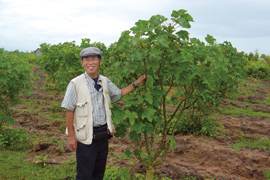The Mitsui & Co. Environment Fund
Introduction to Grant Projects
Shizuoka University Faculty of Agriculture Mutsuo Kojima, Professor
LCA comparisons of biomass fuel and pulp in terms of regionality and scale
Research grant
- Project Description
New sources for paper that have low environmental impact and avoid damage to ecosystems are being sought to limit the effects of mass production and consumption, and there is an intensifying trend towards using wood from designated forests and plantations. However, as 90% of wood chips being used in Japan have been imported from overseas, there is a need to diversify resource procurement using materials such as sugarcane, bagasse, and bamboo, but the advantages and disadvantages of using these resources have yet to be quantified or analyzed numerically. With this in mind, this research aims to quantify the environmental impact of the cultivation, harvesting, transportation, processing and disposal of different biomass materials to provide an objective reference for sustainable biomass resource procurement, as well as create an LCA* comparison model for conducting a comparative study of the environmental impact of different biomass resources in terms of species and scale of cultivation. LCA data will be acquired in cooperation with the following groups: Mitsubishi Paper Mills Limited (pulp, domestically produced wood chips, and recycled wastepaper), Chuetsu Pulp & Paper's Sendai Plant (bamboo chips), the Eco Future Fund (eucalyptus and kenaf chips, etc.), Nippon Biodiesel Fuel (biofuel), the Raks Thai Foundation, EPPCO, and the Sugarcane Functional Research Center.
*Life Cycle Assessment - a method for comprehensively assessing environmental impact at every stage of a life cycle including production, transportation, usage, disposal, and reusage.
- Fields
- Climate changeEnergy problem
- Grant year
- FY2007 Research Grants
- Grant term
- 2 years
April 2008 - March 2010
- Grant amount
- 13,604,000 yen
- Activity region
- Japan, Thailand, Indonesia, Brazil, others

It has a life-cycle of one year from planting to cutting
Overview of the Organization

- Representative
- Mutsuo Kojima, Professor
- Profile
- Specialist fields
Forest symbiosis, community development and revitalization theory, agricultural environmental science theory
Affiliated academic societies
The Japanese Forest Society, The Japanese Forest Economic Society, the Japan Society of Fujiology, Japan Association on the Environmental Studies
Background
1972 - left the Kyushu University Faculty of Agriculture's doctoral program without doctorate and became a research assistant at the Shizuoka University Faculty of Agriculture in June of the same year. Became an assistant professor and then professor in 1992. Doctorate in agriculture. - WEB site
- http://www.shizuoka.ac.jp/
- Co-researchers
- Kyoji Suzuku, professor, Shizuoka University Faculty of Agriculture; Satoshi Matsuda, associate professor, Shizuoka University Faculty of Engineering, Hiroaki Takahashi, chairperson, the Eco Future Fund
- Research record
-
- (1) Hiroshi Murai, various authors, "Japan's coastal forests." Soft Science Co., 1992
- (2) Various authors, Masahiko Shiraishi ed., "Cooperative associations for an era of new principles." Ie-no-Hikari, 1996
- (3) Various authors, "A New Forester's Guide." Zenrinkyou, reprinted in 1996
- (4) Various authors, "Human environmental science theory" (not for sale/ out of print) Shizuoka University Department of Human and Environmental Science, 2002
- (5) Various authors, Masahiro Sakia ed., "Socialization of Forest Resources Management." Kyushu University Press, 2003
- (6) Co-author, "Research on consensus formation between organizations in forest building collectives" Nasutaifutanaka Forest Research No26., 2007
- (7) Co-author, "A comparitive study of ecotourism and environmental conservation in South Korea and Japan." 115th Academic Lecture on Forestry 2004
- (8) Co-authored with Wino Herdiana, "Research on ecotourism and envronmental conservation in tropical regions", 115th Academic Lecture on Forestry, 2004